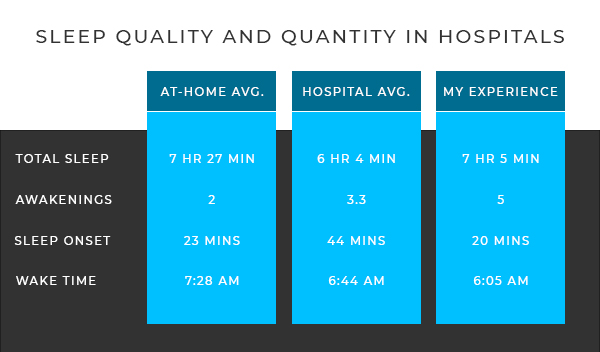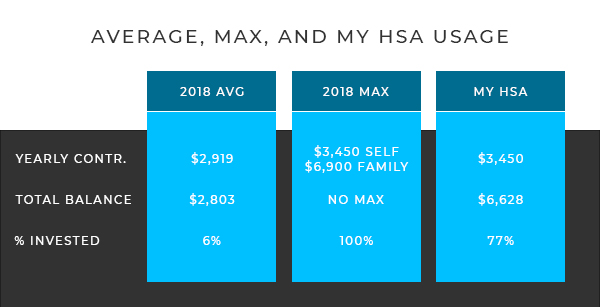We’ve made it to the final post in the series of what I learned in the emergency room. First, I discussed how nutritionally poor the food is in hospitals. Second, I talked about how misdiagnoses can happen and how you can prevent them. And third, today, I’m going to cover three more essential topics in health and wellness, and how they were affected by my emergency room visit: Sleep, Physical Activity, and Finances. Let’s get into it!
Poor Sleeping Conditions are Rampant
Did you know that people who live next to airports have significantly lower quality sleep than those who don’t? This is because the noise at night from the planes overhead can disrupt sleep cycles even if they don’t wake us. Did you know that people who live in the city that keep their curtains open and let streetlight in their bedroom have lower quality sleep than those who don’t? This is because even dim light in our bedroom limits our body’s melatonin production and thus reduces our sleep quality. And we all know that if we have kids, and they’re waking us up throughout the night, that our sleep quality is much poorer because of those awakenings even if we get the same duration of sleep. All of these poor sleeping situations on their own cause problems with our sleep quality. Put them together, and it’s a sleeping nightmare that disrupts our immune system and recovery/rest process.
But what happens when we sleep in the emergency room or at a hospital? Nurses talking, televisions blaring, and medical equipment beeping. Lots of noise. There are also medical equipment lights, hospital lights, and electronic lights. Lots of light. And don’t forget about the staff waking you throughout the night to check your vitals. These are just a few of the factors causing patients to sleep about 1 hour and 30 minutes less in hospitals compared to their houses. This can’t be good for those in the hospital who are prioritizing health and recovery.

And when I was there, I experienced most of these factors. This was amplified by the fact that I didn’t have my own room so there weren’t walls between me and many of the patients. This meant it was noisy and there was always light present. I even had my vitals taken a couple times at night which woke me. But, surprisingly, there was a bright spot. My hospital provided me with a sleep kit! Oh my god, I loved it. There was a pamphlet explaining how important maintaining a proper sleep environment was. There were ear plugs to drown out the noise. And there was a sleeping mask to block out the light. I was so excited when I got this that it was a little embarrassing. But it helped! While I did wake up a few times throughout the night, I got over seven hours of total sleep and fell asleep quite quicky. So, while my sleep wasn’t as great as it would’ve been at home, it was better than what most people get in the hospital. Therefore, if you’re ever spending the night in the hospital, see if you can get a hold of some ear plugs and a sleeping mask. Also, it might be worth asking if they can hold off on taking your vitals until the morning. These steps will help ensure a quicker recovery.
Your Physical Activity is Limited
What about physical activity? We all know that exercise is healthy and those that exercise are less likely to be hospitalized than those who don’t. But what about when you’re already in the hospital? Can physical activity help you recover quicker? Several studies say yes. More physical activity has been correlated with shorter hospital stays, less readmissions, and less complications. While this may not be the case with every illness or injury, it is the case for many and it’s worth asking your doctor about. When we increase our physical activity, we increase our heart rate, which increases our blood flow, which increases nutrient and oxygen delivery throughout the mind and body. This can help with stress, anxiety, immune system functionality, and the overall healing process. All making for a better hospital stay.
But, when I was at the hospital, it wasn’t recommended to walk the ward because of the pandemic. This made it difficult to not be sedentary and bedridden. Despite this, I decided to complete a mini workout next to my bed. Some bodyweight squats, lunges, push-ups, arm circles, stretches, and balance exercises. Anything just to loosen up my joints and get the blood flowing. And it turns out that physical activity would’ve helped with constipation if I had it and does help with preventing kidney stone formation. So, although it would have been a little awkward if a hospital staff member walked in on me doing push-ups, I’m sure it helped a little in my recovery. Therefore, if you’re ever in a comparable situation, don’t be afraid to walk the ward or perform some light physical activity if permitted by your doctor. These trivial things can make a significant difference in your health and recovery.
Medical Bills Add Up Quick
Despite all my efforts to recover as quickly as possible, a trip to the emergency room is still a trip to the emergency room. Which can be costly. The average emergency room visit costs around $250 if you have copay insurance. That cost rises to over $1,000 if you have a high-deductible plan and can reach upwards of $10,000 if you’re uninsured. That’s brutal. Luckily, a Flex Spending Account (FSA) with copay plans or a Health Savings Account (HSA) with high-deductible plans can help you foot the bill. And if you aren’t funding an eligible account, then an emergency fund will do the trick too.

So far, I’ve received two bills from my trip to the emergency room totaling $1,135 and there may be more on the way. But I’ve consistently been following my 7 Steps to Financial Freedom which eased most of the stress. Not only do I have an emergency fund that would’ve covered the costs, but I’ve been maxing out my HSA for a few years now. Therefore, the bills got paid right away from my HSA. Although it’s sad to see that amount of money get deducted from an account I’ve been steadily growing, that’s what the account is for and it worked as planned.
Final Thoughts
While no one expects or plans to go to the emergency room, it’ll likely happen to you at some point. Therefore, I’ve compiled a list of three more lessons I learned to better prepare you for the situation. Sleep is important for your recovery process, but the hospital isn’t the most conducive environment. Ask if there are ear plugs or a sleeping mask you can use to help get a better night’s rest. Physical activity can help reduce your length of stay in many cases too. If permitted by your doctor, try to walk the ward, perform some bodyweight exercises, or at least stand up and stretch to get the blood flowing. Lastly, have a fully funded emergency fund or FSA/HSA to cover the medical costs. This will ease your stress and anxiety which will allow you to focus on your recovery. All of these steps will help make your emergency room visit healthier and happier.
Are you looking for a program that prevents disease, death, and disability?
Watch a YouTube Video Summarizing the Post

Hey, I am Brandon Zerbe
Welcome to myHealthSciences! My goal has always been to increase quality-of-life with healthy habits that are sustainable, efficient, and effective. I do this by covering topics like Fitness, Nutrition, Sleep, Cognition, Finance and Minimalism. You can read more about me here.
Sources:
- Quality and Quantity of Sleep and Factors Associated With Sleep Disturbance in Hospitalized Patients
- Sleep Quality of Hospitalized Patients, Contributing Factors, and Prevalence of Associated Disorders
- Walking Around Is The Simplest Way To Shorten Hospital Stay, Study Finds
- Walking In Hospital Is Associated With A Shorter Length Of Stay In Older Medical Inpatients
- The Relationship Between Physical Activity And Post-Operative Length Of Hospital Stay: A Systematic Review
- Average Cost of an ER Visit
- Trends in Health Savings Account Balances, Contributions, Distributions, and Investments, 2011‒2018: Estimates From the EBRI HSA Database
